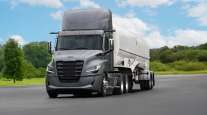Senior Reporter
Daimler AG Reports Record Sales in 2017

Diversified manufacturer Daimler AG reported it sold a record 3.3 million vehicles in 2017 — including a 13% increase in truck sales — as full-year revenue and earnings also peaked amid a strong fourth quarter.
The gains came as the original equipment manufacturer forecast increased truck production and slight overall growth in sales of cars and buses in 2018. Daimler emphasized its future lay in the combination of connectivity, autonomous, sharing and electric mobility technologies.

“It’s about nothing less than the reinvention of individual mobility,” Daimler CEO Dieter Zetsche said in a company release detailing the earnings.
Daimler, based in Stuttgart, Germany, reports in euros.
Net income equivalent in dollars for the quarter ended Dec. 31 surged to $4.1 billion, or $3.72 per share, on sales of $54 billion. That compared with $2.7 billion, or $2.50, on sales of $51 billion in the 2016 period.
For the full year, net income rose to $13.6 billion, or $12.25, on sales of $204.5 billion. In 2016, net income was $10.9 billion, or $9.92, on sales of $191 billion.
Turning to trucks, Daimler, the world’s largest heavy-duty truck maker, sold 133,711 units in the quarter compared with 104,019 a year earlier. For the 12-month period, sales climbed to 470,705 compared with 415,108.
Its North American unit, Daimler Trucks North America, ended 2017 with total U.S Class 8 retail sales of 77,305 through its leading Freightliner brand and its niche vocational unit Western Star, according to WardsAuto.com.
DTNA sold another 53,975 Freightliner trucks last year in Classes 4-7 and its Mitsubishi Fuso unit sold 949 trucks in Classes 3-5.
Also, Daimler AG, reported its global truck division’s fourth-quarter earnings before interest and taxes increased 60% to $691 million compared with $432 million. For the full year, EBIT rose 22% to $2.9 billion compared with $2.4 billion.
The percentage gains in EBIT for both periods at the truck unit were the highest among all the company’s divisions.
Truck-generated revenue in the quarter rose 13% to $11.8 billion compared with $10.56 in the 2016 period. For the full year, it rose 8% to $44.4 billion compared with $41.3 billion a year earlier.
Daimler had a quarterly return on sales [or operating profit margin] for trucks of 5.8% compared with 4.1% in 2016. For the year, RoS was 6.7% compared with 5.9% in 2016, and that 0.8 percentage point increase was the highest earned in all its divisions.
Looking ahead, the company forecast total truck sales will be “significantly higher” in 2018, driven up by recovery in its major markets, including North America, which has been in an ongoing market recovery since mid-2017 — with expected gains in Classes 6 to 8.
In other developments, Daimler reported it continues to evaluate its intention, announced in October, to make its Mercedes-Benz Cars & Vans and Daimler Trucks & Buses into legally independent entities — as already is the case with its Daimler Financial Services unit.
“In the case of a positive result of the feasibility study, we would give the go-ahead for the new company structure in the year 2018,” Daimler CFO Bodo Uebber said in the report. The reorganization is intended to strengthen the divisions’ future viability, especially in light of the industry’s growing push toward electrification.
In related news, Daimler and other German manufacturers are negotiating with the German metal workers union IG Metall and a stalemate persists over pay increases, according to Bloomberg News.
Workers at DTNA’s Portland, Ore., truck plant ratified a new five-year contract with the International Association of Machinists in October 2016. The plant makes Western Star trucks.
UAW members at DTNA North Carolina facilities located in Cleveland, Mount Holly and Gastonia ratified a new four-year collective bargaining agreement in May 2014. The Cleveland plant is the largest that makes Freightliner models.





